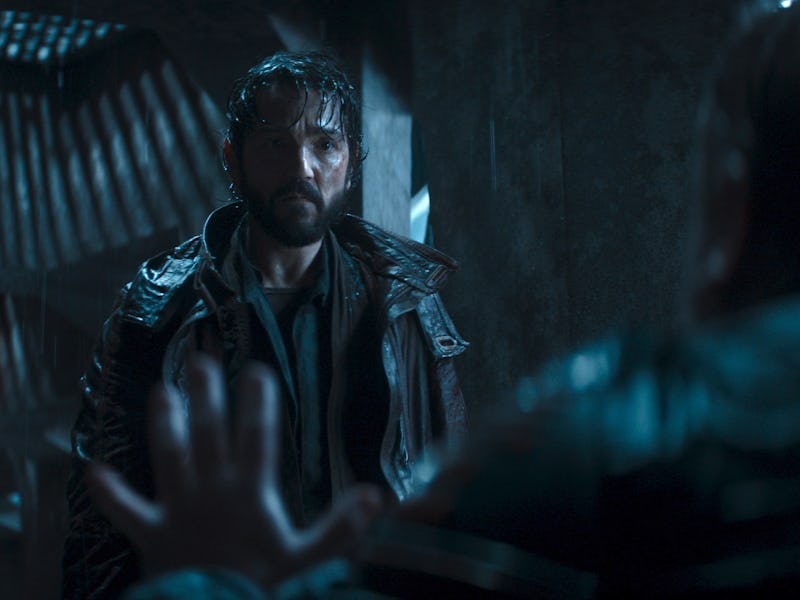Star Wars just rebooted itself with a classic Blade Runner trick
The galaxy far, far away has never looked or felt quite like this.

There’s not a lot of rain in Star Wars. In the classic films, there’s a bit of rain on Dagobah, and that’s about it. The prequels gave us the rain-swept world of Kamino, while the sequels drenched Luke and Rey on Ahch-To for The Last Jedi. But in none of these cases did the use of rain signal an aesthetic shift into noir-territory for Star Wars. In fact, even though Attack of the Clones had nods to Blade Runner’s skyline, the Star Wars saga has never gone full sci-fi noir a la Blade Runner... until now.
Here’s how the seemingly innocuous opening of Andor subtly reboots the aesthetics of Star Wars for the better.
Kravas (Lee Boardman), Verlo (Stephen Wight), hostess (Margaret Clunie), bartender (Caroline Green), and Cassian Andor (Diego Luna) in the first episode of Andor.
Although Star Wars has long been obsessed with depicting seedy otherworldly bars and gambling dens, for the most part, those places tend to either be Easter eggy versions of the original cantina in A New Hope (see: the bar in The Force Awakens) or an intentional opposite, shinier variety of high-class gambling (like in The Last Jedi). Even in The Mandalorian and The Book of Boba Fett, the underworld of Star Wars tends to all emulate the same kind of aesthetic we got from Jabba’s Palace, and again, the original Tatooine cantina. Variations on that theme do occur, but never with the starkness as the opening episode of Andor.
The depiction of the brothel on Morelna One, in the opening minutes of Andor, gives a cyberpunk veneer to the Preox-Morlana Corporate Zone. Not only does none of this look like previous, seedy Star Wars bars, but the establishment that Cassian infiltrates may not even be doing anything illegal. (The only person actually breaking the law here is Cassian, since he’s not actually a Pre-Mor employee.)
Andor drops us into this setting — with its complex rules — without much fanfare, echoing the narrative style not only of Blade Runner but of the cyberpunk novels of William Gibson. Here, Cassian feels more like a character from Neromancer or Count Zero than a traditional hero of the Rebellion.
Cassian (Diego Luna) on Ferrix in Andor.
Although none of this makes Andor an actual, literal reboot of course, the shift in world-building is significant. Yes, the visuals of those opening of Andor remind any sci-fi fan worth their salt of Blade Runner, but the implication is deeper than that: Again, for the most part, when it comes to the “underworld” or the seedier sides of this galaxy, newer Star Wars shows and movies have tended to build on previously established rules, rather than to create new ones. And while it’s true that Solo retroactively redefined the economics of the Star Wars galaxy by codifying the hyperspace fuel Coaxium, it’s not like the film shifted the needle significantly in terms of what we could expect on various planets. The Mandalorian has done a slightly better job at creating unique planets and environments, but because the New Republic governance post-Return of the Jedi is fairly vague, there’s still a generic classic Star Wars-ness to most of the places Mando visits, especially Nevarro.
But Andor isn’t really like that. Ferrix isn’t just a generic Tatooine-esque planet like Jakku or Nevarro. There’s a lived-in quality that isn’t shorthand, but rather slightly more realistic. And if you contrast this with the paper-thin believability of the various Tatooine towns in Book of Boba Fett, the contrast becomes clear: The makers of Andor aren’t just hoping to get by with some vague generic Star Wars aesthetics, at least not to the degree their predecessors were. Instead, there are new rules on these planets. And new aesthetics. For the first time in a very long time, the boundaries of the Star Wars universe finally seem to be expanding.
Andor streams new episodes on Disney+.